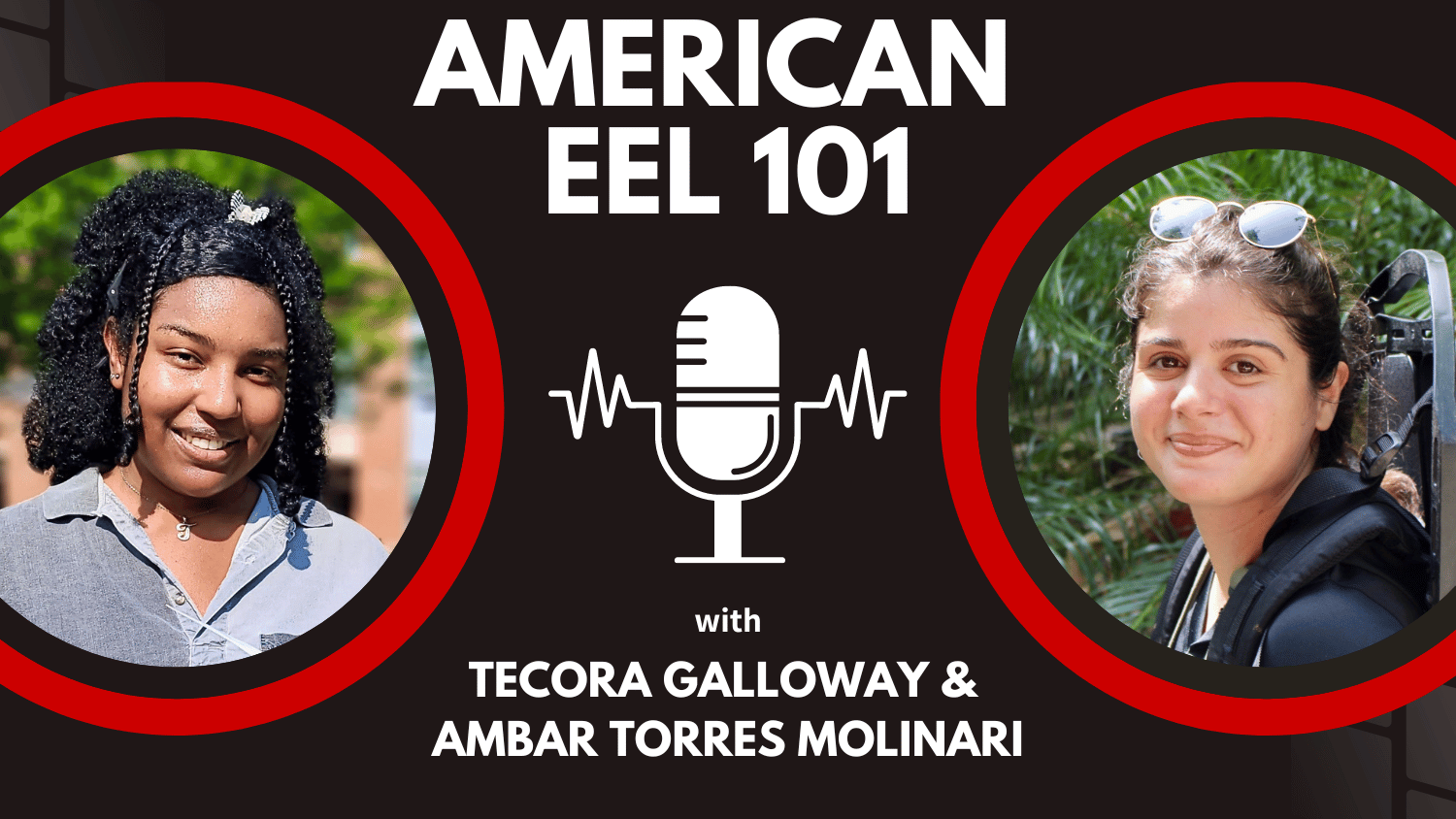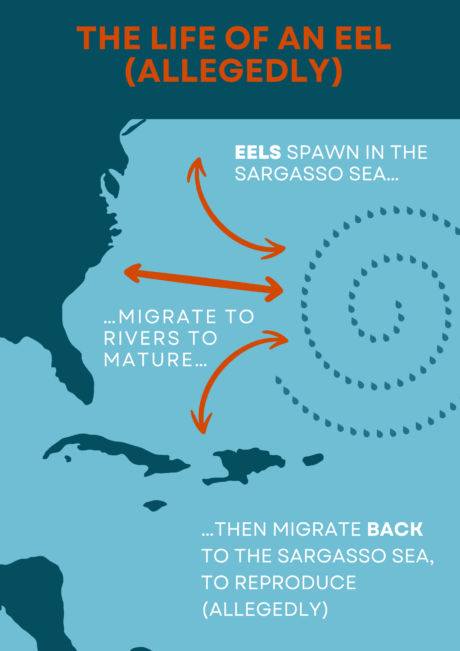
The following blog is a guest post by TeCora Galloway, a science communication intern with SE-CASC and the Science Communicators of North Carolina. TeCora created everything in this post, from editing the interview to the infographics.
My name is TeCora Galloway and I am a rising senior at North Carolina A&T State University. I am studying biology with the intention of becoming a gynecologist. I am interning for the Southeast Climate Adaptation Science Center this summer, and I had the pleasure of interviewing a former Global Change Fellow and recent NC State graduate, Ambar Torres Molinari (ATM). She studied the American eel and their distribution patterns in Puerto Rico.
Our interview below goes over the importance of her research, and conveys how exciting field research can be.
Transcript below
ATM: The American eel is like a mystical creature to a lot of people because you don’t really see them out and about through the water. But it is an amazing fish. Even though it looks like a snake…
It’s a fish?
ATM: Yes. It has gills, it has fins. It is a fish with a snake-like body. This eel primarily lives in like fresh water, but they also have an ocean stage of their life. [I] really like explaining that to people because the eel is a migratory fish. It doesn’t stay its entire life in a single habitat, it needs to migrate to different habitats to complete its life cycle.
I’ve heard kinda the discourse on eels before, where people just don’t know where they come from. They just pop up.
ATM: Yeah. They’re so weird.
That is really weird.

ATM: Yes. Everyone is fascinated to decipher what the heck is going on. They are born in the Sargasso Sea, and then go with the ocean currents.
They’re all born in the Sargasso sea?
ATM: Yes. And once they get to the continental shelf, that’s where they start a bit of a migration. Then you have what are called glass eel. Glass eel are baby eel that are really transparent. They look like a piece of hair.
Oh, what? I was with you until you said they look like hair.
ATM: They’re really thin! They’re like little noodles.
They arrive like that and they either choose to stay where they’re at, which is pretty close to the ocean, or they can choose to make these really long migrations up the river. Whenever they’re like sufficiently developed, they can migrate from Canada all the way to the Sargasso Sea or the Gulf of Mexico. They are all migrating to the same location, but no one has ever seen them spawn in nature. We don’t know where the spawning is taking place.
What you focused on with your research was where they’re migrating to, not so much why they’re going to those places?
ATM: Our research focuses on their freshwater part of their life cycle, not so much the ocean. The main objective is “Does the size of American eel change with like downstream to upstream? Like, are we finding bigger eels, smaller eel and are eel female or male, predominantly in downstream or upstream environments?”
This is one of the first studies that have been done in Puerto Rico for this objective.
We don’t know what is happening in the southern parts of the eels range. And by southern parts we mean the Caribbean, the Gulf of Mexico, South America.
It comes with its challenges because one, we don’t know where the reproductive population is, and two, to manage the species across like, its entire range is something that will make you go crazy. We’re trying to both increase the amount of information for the Caribbean, and see if Puerto Rico is contributing to this overall population.
How did you get into eels?
ATM: I did my bachelor’s in the University of Puerto Rico.
My advisor at the time suggested that I work with fish. He’s like “How about you try this for your undergrad thesis? It’s a migratory gobi in, like, our streams and they migrate based with the phases of the moon.
I was doing research and there was one time that everyone was in the water, and then a wave hit and I saw this snake jumping out of the water. It didn’t like register in my mind that it might be an eel, and I was like, screaming at them, “Get out of the water!” But then I was like, “Oh it was an eel!”
And I was like, “man, this fish is really cool!” But obviously I didn’t think down the line I would do research with it, but then I did a few tech jobs in Puerto Rico that had us sample all fish throughout different rivers. Then [I] also did an internship with one of their [NC State’s] PhD students in Puerto Rico. And he reached out and mentioned that they had a project with the eel and I was like, “Sign me up!”
When you say you survey, are you counting fish? You sit on the side of the river and count them as they come?
ATM: No. We use something called a backpack electrofisher. You put it on like a backpack, and it’s an electrical unit with a battery. You have the anode and the cathodes, and we hold those like broomsticks. They go inside the water, and whenever we turn it on at specific amps there’s an electrical field that creates between those two.
Whatever fish goes through it will become numb and that gives us a chance to swipe ’em up with a net. You have to be really quick to catch them cuz if not they’ll just flow down.
They just go numb? It doesn’t kill them does it?
ATM: It doesn’t kill them. It temporarily numbs them, but it wears off quickly. Different fish have different tolerances to it.
There are fish that you can literally just put it near ’em and it doesn’t do anything. So eel were closer to the side of it doesn’t do anything.
Oh!
ATM: These eel are literally like spaghetti, so you have to look for the eel in the water without putting your hands in it cuz you don’t wanna electrocute yourself while you have that on.
It sounds dangerous, but it’s not at all.
It’s such a fun experience cuz it’s like a little game. Usually [we] have like a team of four people, and everyone’s like “get it, get it!” everyone’s screaming and it’s exciting.
After that, we just count them, measure them, weigh them. Some we release, and the others we keep for analysis to see if they’re female or male.

What we found in Puerto Rico is that in downstream environments you have a ton of eel. High density. As you go farther from the mouth of the river up into the mountains, you’ll have a decrease in American eel, so you’ll have lower densities upstream.
We also found that downstream the general pattern is that they will be shorter, smaller, and once you go up the river, they were much larger.
These larger eel were also female, so we found that female are in upstream environments. That tells us that habitats upstream are excellent for developing female eel that are super large. When they’re large they’re gonna be better prepared to do those long migrations back.
It also gave us a good indication that Puerto Rico might be significantly contributing to that overall population, especially cause you have the Sargasso Sea really close by. So you have them doing shorter migrations because they’re in Puerto Rico, compared to Canada. As you migrate longer, your chances of surviving are not the same.
Who does this benefit? Are we doing this for the eels? Other fish in the area?
ATM: Yeah, good question. To have information that benefits the eel, will benefit people that harvest eel, that fish for eel, [and] that eat the eel.
You know, not have it [the eel] be threatened or continue to decline. So we wanna make sure that that resource is still there and so any steps that we can take to better understand the status of this part of the population in the Caribbean, I think that’s a major step forward.
—
TeCora’s internship was co-funded by grants from the Science Communicators of North Carolina, Burroughs Wellcome Fund, the Southeast Climate Adaptation Science Center and the National Climate Adaptation Science Center.